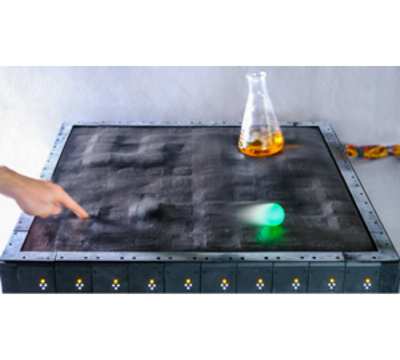| Shape Shifting Display With A Sense Of Touch |
| Written by Sue Gee | |||
| Sunday, 13 August 2023 | |||
|
Researchers at the University of Colorado Boulder and the Max Planck Institute for Intelligent Systems have developed a robotic surface that can change its shape. Watch the video to see it in action. According to a post to Robohub by the Max Plank Institute for Intelligent Systems, the device, which is the size of a Scrabble board, is made from a 10-by-10 grid of soft robotic “muscles” that can sense outside pressure and pop up to create patterns. It’s precise enough to generate scrolling text and fast enough to shake a chemistry beaker filled with fluid. We first came across the idea of using actuators for a shape shifting surface in 2013 when we met inFORM, a Dynamic Shape Display from the Tangible Media Group at MIT Media Lab. Since then there have been many explorations of shape changing interfaces and shape morphing surfaces with applications from information displays, thru human interaction to manipulation of objects. The CU Boulder/Max Planck Institute research aims to overcome the shortcomings of existing approaches that limit their proposed applications by integrating high-speed soft robotic actuators and sensors with natural mechanical compliance to form a shape display with embedded sensing and control. The team's display is composed of scalable cellular units which tightly integrate soft actuation, embedded deformation sensing, and control. Each cell in the 10 by 10 grid is driven by a Hydraulically Amplified Self-healing ELectrostatic (HASEL) actuator, a class of soft electrohydraulic actuator that exhibits high actuation frequency, that had been pioneered by a team led by Christoph Keplinger, formerly an assistant professor of mechanical engineering at CU Boulder and now a director at MPI-IS. The actuators are made of plastic pouches shaped like tiny accordions. If you pass an electric current through them, fluid shifts around inside the pouches, causing the accordion to expand and jump up. The prototype display isn’t ready for the market yet. But the researchers envision that, one day, similar technologies could lead to sensory gloves for virtual gaming or a smart conveyer belt that can undulate to, for instance sort apples from bananas. Whatever uses are found for it, it could soon provides a sense of touch that has been missing from the world of digital technology. Mantas Naris, co-lead author of the paper says: “You could imagine arranging these sensing and actuating cells into any number of different shapes and combinations. There’s really no limit to what these technologies could, ultimately, lead to.” More InformationA multifunctional soft robotic shape display with high-speed actuation, sensing, and control in Nature Communications 14.1 (2023): 4516.l. Johnson, B.K., Naris, M., Sundaram, V., Volchko, A., Ly, K., Mitchell, S.K., Acome, E., Kellaris, N., Keplinger, C., Correll, N., Humbert, J.S., and Rentschler M.E. 3D display could soon bring touch to the digital world Related ArticlesTo be informed about new articles on I Programmer, sign up for our weekly newsletter, subscribe to the RSS feed and follow us on Twitter, Facebook or Linkedin.
Comments
or email your comment to: comments@i-programmer.info |
|||
| Last Updated ( Sunday, 13 August 2023 ) |



